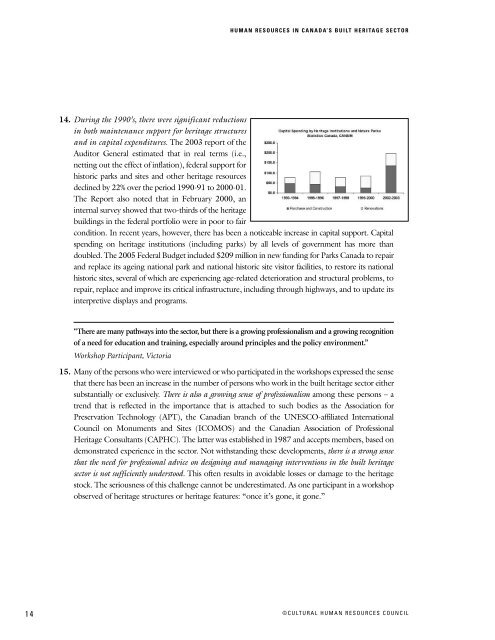Human Resources in Canada's Built Heritage Sector: Mapping the ...
Human Resources in Canada's Built Heritage Sector: Mapping the ...
Human Resources in Canada's Built Heritage Sector: Mapping the ...
- No tags were found...
You also want an ePaper? Increase the reach of your titles
YUMPU automatically turns print PDFs into web optimized ePapers that Google loves.
HUMAN RESOURCES IN CANADA’S BUILT HERITAGE SECTOR14. Dur<strong>in</strong>g <strong>the</strong> 1990’s, <strong>the</strong>re were significant reductions<strong>in</strong> both ma<strong>in</strong>tenance support for heritage structuresand <strong>in</strong> capital expenditures. The 2003 report of <strong>the</strong>Auditor General estimated that <strong>in</strong> real terms (i.e.,nett<strong>in</strong>g out <strong>the</strong> effect of <strong>in</strong>flation), federal support forhistoric parks and sites and o<strong>the</strong>r heritage resourcesdecl<strong>in</strong>ed by 22% over <strong>the</strong> period 1990-91 to 2000-01.The Report also noted that <strong>in</strong> February 2000, an<strong>in</strong>ternal survey showed that two-thirds of <strong>the</strong> heritagebuild<strong>in</strong>gs <strong>in</strong> <strong>the</strong> federal portfolio were <strong>in</strong> poor to faircondition. In recent years, however, <strong>the</strong>re has been a noticeable <strong>in</strong>crease <strong>in</strong> capital support. Capitalspend<strong>in</strong>g on heritage <strong>in</strong>stitutions (<strong>in</strong>clud<strong>in</strong>g parks) by all levels of government has more thandoubled. The 2005 Federal Budget <strong>in</strong>cluded $209 million <strong>in</strong> new fund<strong>in</strong>g for Parks Canada to repairand replace its age<strong>in</strong>g national park and national historic site visitor facilities, to restore its nationalhistoric sites, several of which are experienc<strong>in</strong>g age-related deterioration and structural problems, torepair, replace and improve its critical <strong>in</strong>frastructure, <strong>in</strong>clud<strong>in</strong>g through highways, and to update its<strong>in</strong>terpretive displays and programs.“There are many pathways <strong>in</strong>to <strong>the</strong> sector, but <strong>the</strong>re is a grow<strong>in</strong>g professionalism and a grow<strong>in</strong>g recognitionof a need for education and tra<strong>in</strong><strong>in</strong>g, especially around pr<strong>in</strong>ciples and <strong>the</strong> policy environment.”Workshop Participant, Victoria15. Many of <strong>the</strong> persons who were <strong>in</strong>terviewed or who participated <strong>in</strong> <strong>the</strong> workshops expressed <strong>the</strong> sensethat <strong>the</strong>re has been an <strong>in</strong>crease <strong>in</strong> <strong>the</strong> number of persons who work <strong>in</strong> <strong>the</strong> built heritage sector ei<strong>the</strong>rsubstantially or exclusively. There is also a grow<strong>in</strong>g sense of professionalism among <strong>the</strong>se persons – atrend that is reflected <strong>in</strong> <strong>the</strong> importance that is attached to such bodies as <strong>the</strong> Association forPreservation Technology (APT), <strong>the</strong> Canadian branch of <strong>the</strong> UNESCO-affiliated InternationalCouncil on Monuments and Sites (ICOMOS) and <strong>the</strong> Canadian Association of Professional<strong>Heritage</strong> Consultants (CAPHC). The latter was established <strong>in</strong> 1987 and accepts members, based ondemonstrated experience <strong>in</strong> <strong>the</strong> sector. Not withstand<strong>in</strong>g <strong>the</strong>se developments, <strong>the</strong>re is a strong sensethat <strong>the</strong> need for professional advice on design<strong>in</strong>g and manag<strong>in</strong>g <strong>in</strong>terventions <strong>in</strong> <strong>the</strong> built heritagesector is not sufficiently understood. This often results <strong>in</strong> avoidable losses or damage to <strong>the</strong> heritagestock. The seriousness of this challenge cannot be underestimated. As one participant <strong>in</strong> a workshopobserved of heritage structures or heritage features: “once it’s gone, it gone.”14©CULTURAL HUMAN RESOURCES COUNCIL










